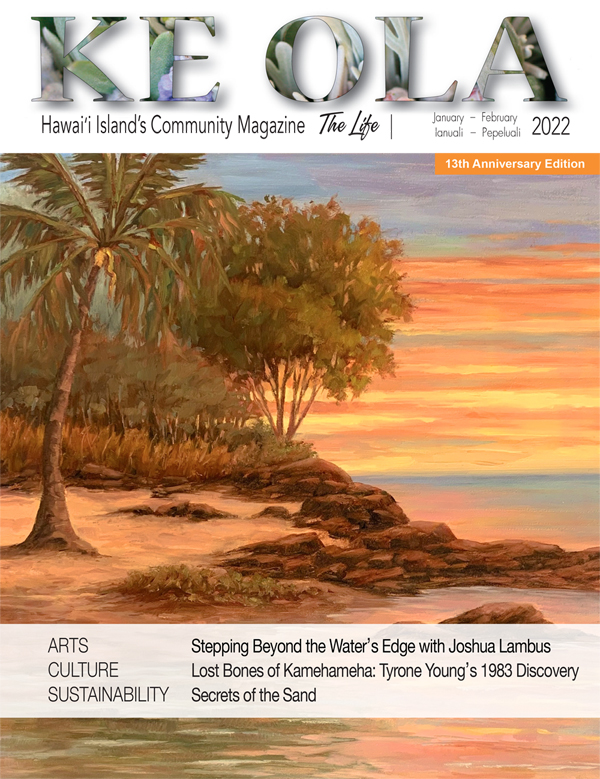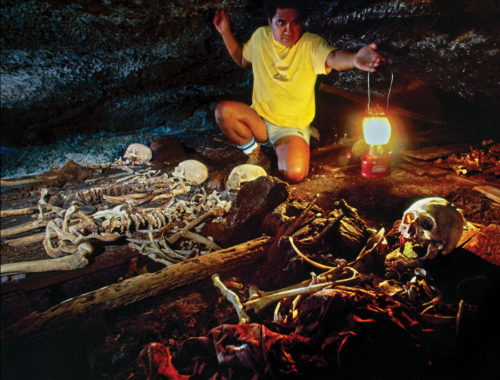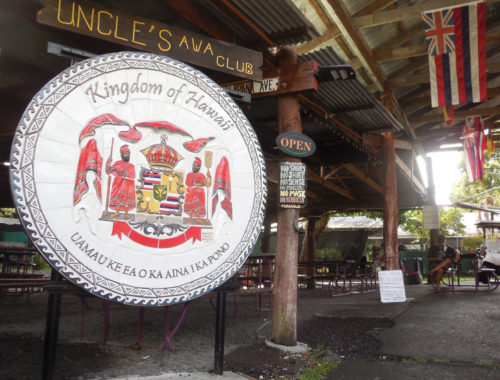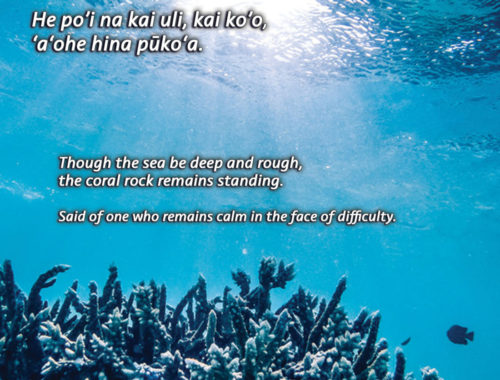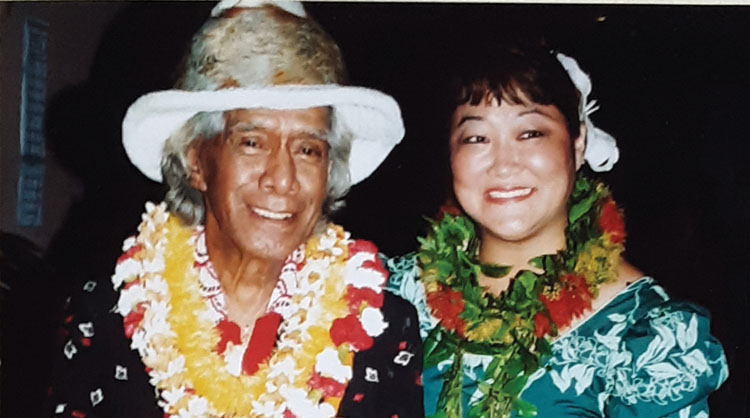
Ka Lei Aloha with Kumu Hula Lori Lei
By Nancy S. Kahalewai
“I’m going to dance with them!” Lori Lei Shirakawa Katahara announced to her mom when she was only four years old. They were watching their family friends at a hula recital, and she started to get up to join them. Her mom literally held her back, explaining that these girls had been practicing for years. “Mom later sent me to Dot’s Dance Studio in Hilo in the mid-60s. I danced with Kumu Hula Dorothy Horita for 13 years up until my high school graduation. Aunty Dot learned from Kumu Hula Rose Kuamo‘o,” Lori Lei recalls.
Learning from the Masters
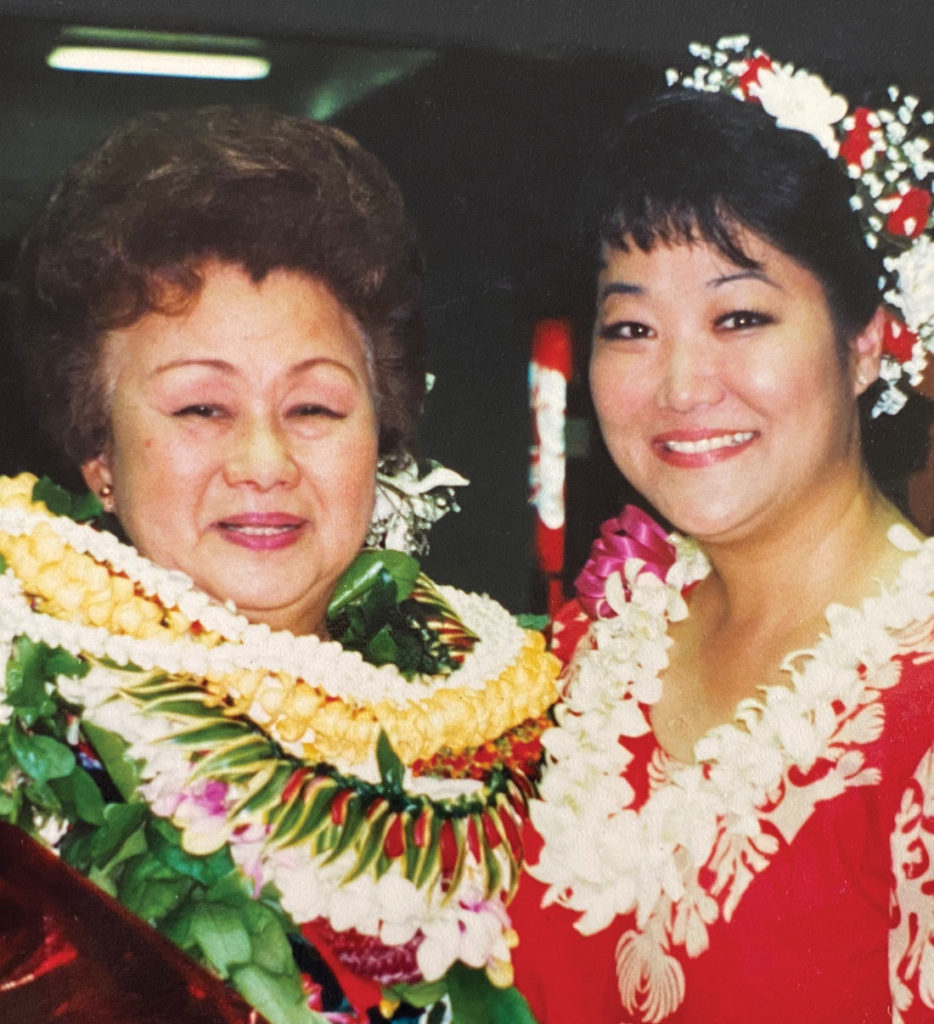
Lori Lei later joined hula master George Lanakilakeikiahialii Naope’s hula studio. “We had weekly hula lessons under the Hilo Hawaiian Hotel. The floor was concrete and boy did Uncle George work us! We went home with ‘strawberries’ on our knees and feet from learning hula noho [sitting hula]. Part of our training was performing at the weekly boat shows. We were compensated with fruit punch and cookies, the joy of dancing to a live audience, and the invaluable knowledge shared by Uncle George.”
Not only did they experience the depth and discipline of being taught in a coveted hula hālau under strict “old-school” style, but they also learned how to create traditional foliage adornments. They had to make fresh lei every week and new ti leaf skirts about every three weeks for their performances on the SS Independence cruise ship that was docked in Hilo Harbor. “For ‘auana [modern dances] we picked yellow plumeria flowers to put in our hair and make a lei. For kahiko [ancient dances] we made lei po‘o, ‘ā‘ī and kūpe‘e from mock orange leaves for our head, neck, wrist, and ankles,” Lori Lei remembers.
Kumu Hula George Naope, considered an expert in traditional Hawaiian chants and the oral history of the Hawaiian culture, co-founded Hilo’s famous Merrie Monarch Festival. Later, he moved to Kona, where he founded the Hawai‘i Kūpuna Hula Festival. After dancing for Uncle George in the 1980s, and after decades of watching her teach, he honored Lori Lei with a formal palapala (certificate of hula excellence) in 2007. He died in 2009 at the age of 81.
While modeling for a local artist’s fashion show, Lori Lei met Kumu Hula Glenn Kelena Vasconcellos, who at the time was creating fabulous hairstyles on the models right on the runway stage while the show was going on. She joined his hālau and danced in her very first Merrie Monarch hula competition with Halau ‘O Ke ‘Anuenue in 1983.
Lori Lei later joined Kumu Hula Rae Kahikilaulani Fonseca’s Halau Hula ‘O Kahikilaulani. She was surprised and honored to be chosen as one of his dancers for the 1989 Merrie Monarch hula competition in which they were awarded second place in both the wahine kahiko and ‘auana divisions.
Life in Ka‘ū
When she moved to Ka‘ū in 1990 with her family, the Hawai‘i County Parks and Recreation department phoned Lori Lei and asked her if she would teach hula to their seniors. “With the blessings from my kumus, I began teaching the kūpuna women at the Nā‘ālehu Senior Center.” Upon the requests of her students to teach their grandchildren too, she soon had so many students that she had to create multiple classes based on their ages. Her following had outgrown the center, so the former Kauaha‘ao Congregational Church Hall in Wai‘ohinu became her new hula studio.

At one time, Lori Lei had about 150 students and taught hula classes in Wai‘ohinu, Hilo, Kona, and Waikoloa. Today, she teaches only in Hilo and her Lori Lei’s Hula Studio has approximately 75 dancers, ranging in ages from three to 81 years young. She also teaches weekly hypertension hula classes for Hui Mālama Ola Nā ‘Ōiwi.
She shared a precious story about her days in Ka‘ū, “While teaching the song ‘Ka Nani A‘o Ka‘ū’ to the kūpuna wahine, one of the dancers, Aunty Esther Beck from Maui, shared the story of how that song came to be: Uncle George was visiting his Aunt Sarah Ke in Nā‘ālehu, and she asked him: ‘Keoki, have you seen Palahemo [a brackish pond in Ka‘ū]?’ Since he hadn’t, Sarah arranged a sightseeing trip to South Point with her daughter Esther and Esther’s husband Leighton Beck, showing him the sights of the southernmost point of the island. All the way, Uncle George was in contemplation while tuning his ‘ukulele, repeatedly plucking G-C-E-A as he absorbed the beautiful scenery.
“Upon returning from his huaka‘i (excursion), he had composed his famous mele ‘Ka Nani A‘o Ka‘ū’. If you listen carefully to the melody, you will hear those four main notes in every verse of the song! That evening, he surprised Aunt Sarah and sang it for the first time at their gathering outside of her home. This beautiful song has blessed many since, and has become the proud ‘anthem’ for the people of Ka‘ū.”
Lori Lei also fondly recalls that it was Aunty Hattie Macomber, her wise and loving Wai‘ohinu neighbor, who mentored her on profound hula and life insights such as, “Always pule [pray] before a performance.” She also told her traditional tips including, “Always wear a green ti leaf for protection: put a fresh piece somewhere on your body—wear it or tuck it under your clothes if you have to!” This protective custom still strongly prevails in the Hawaiian Islands, which is why many families grow green ti plants around their homes.
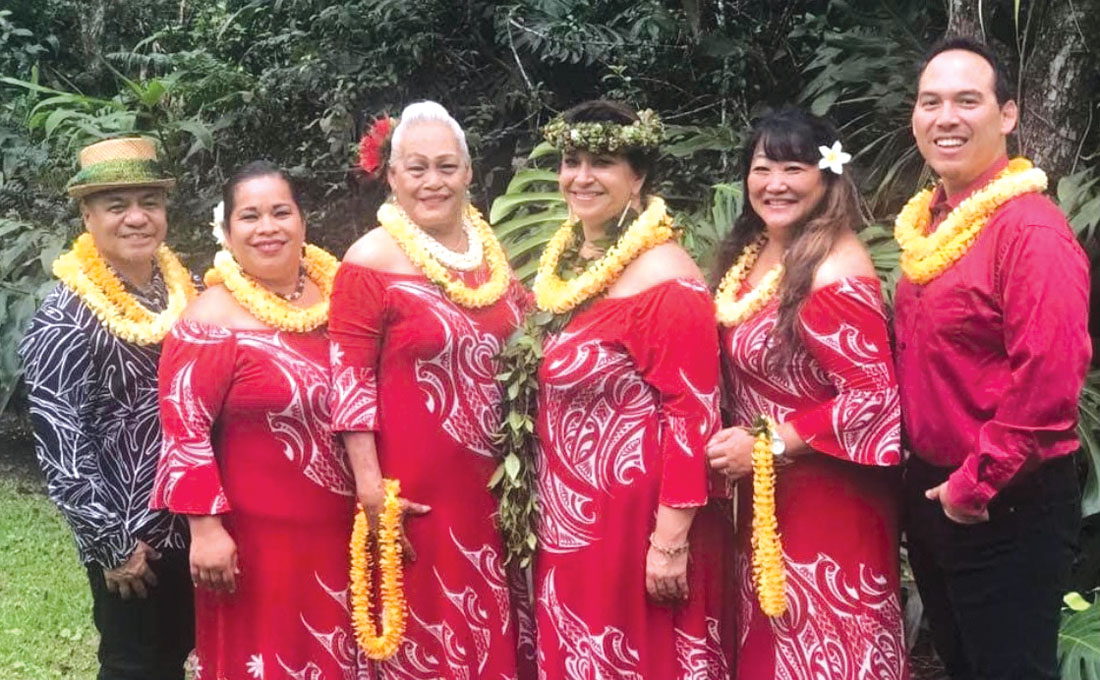
‘Ūniki
One day, Kumu Rae Kahikilaulani Fonseca decided to select his future ‘ūniki (graduates) to carry on his lineage and legacy as teachers. “Kumu tasked us each to create an ‘oli or mele. I was feeling overwhelmed, so I prayed to God to help me. In the middle of the night, I sat up, half asleep, and wrote down my thoughts.” As she read it the next morning, she was surprised and realized it was divinely inspired. She turned to her friend Kaliko Trapp-Beamer, a master in ‘olelo (Hawaiian language), asking him to please translate it. “And he did. He named it ‘Mele Mahalo,’ which describes a song of gratitude. It is about the true meaning of why I am here, and fulfilling my kuleana as a kumu hula. In the first verse, the line Ka wai a Ke Akua e ola mau nei represents the nurturing and forgiving ‘divine waters of life, forever flowing’. I believe this is God’s gift to all of us, once we accept it.”
Lori Lei and five others were chosen on March 24, 2007 at a huge ‘ūniki celebration at Sangha Hall in Hilo. While she did not fully realize it at the time, she was being groomed to carry forth a new life-changing legacy, spreading the aloha spirit to all through hula.
She and her fellow ‘ūniki, whom she calls her “hula brothers and sisters,” still share a very strong and special bond. Kumu Rae passed suddenly on March 20, 2010. “Since our kumu passed, we only have each other to call on and support one another.” In preparation for their 25th Anniversary Hō‘ike, she invited her hula brother Kawika Alfiche to teach her students an ‘oli. “We spent a weekend at Kalōpā Park, near where Kumu Rae’s ashes had been scattered. One evening, we had an amazing ‘chicken-skin’ experience while Kawika was teaching us a chant for the occasion in the Hall. He said, ‘Louder! Chant from your na‘au!!’ And we did. Suddenly a folded metal chair leaning up against the wall fell hard and loudly! Kawika immediately responded, ‘Oh, hello Kumu!’ We all felt Kumu Rae was with us. There was no wind and the windows and doors were closed—no way that chair could have fallen!”
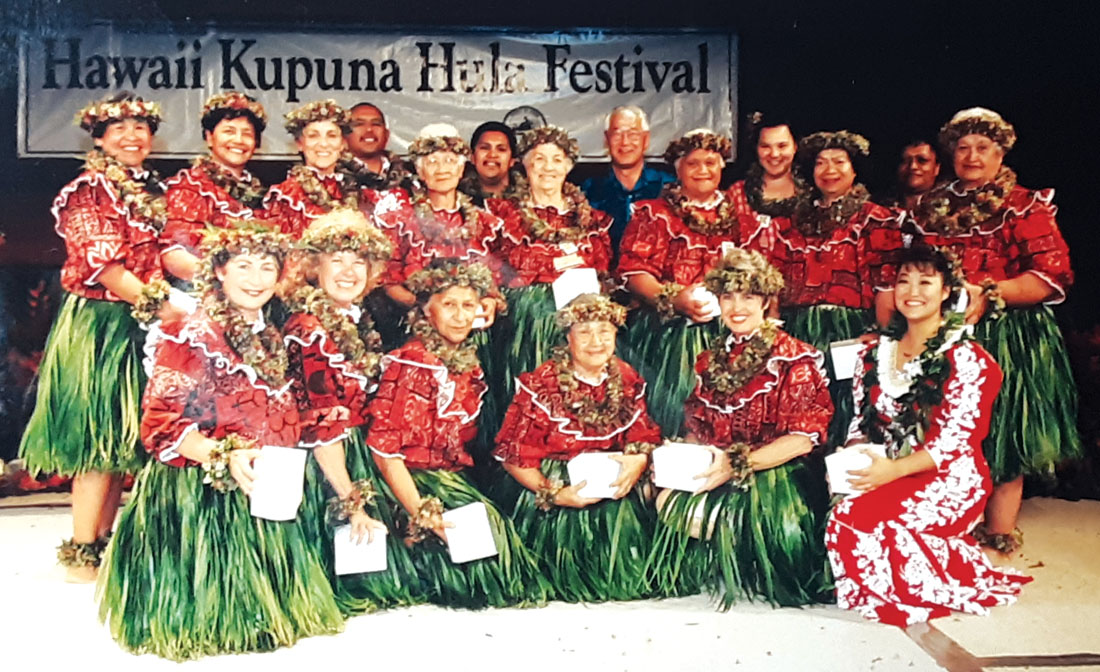
E ola mau i ka hula
Lori Lei has recently remarried and lives in Hilo with her husband Cleve, and her sons, Tyler and Noah. Her classes are mostly non-competitive, although the haumana (students) do enjoy being part of Hawai‘i Kūpuna Hula Festival. “My kūpuna enter for the pure love of the hula, and to be with other kūpuna who have become lifelong friends. We don’t go there expecting to win, but are pleasantly surprised when we do. My hula studio is open to everyone, young and old, no matter their capabilities as long as they want to learn hula. All are welcome!”
Since the days of dancing on the ships, she always scanned the audience for someone to give her lei to after the performance. “People were always so surprised and grateful!” Today it has become a Lori Lei’s Hula Studio custom for the haumana to give their lei away to someone after their performances. “It’s our way of showing that the aloha spirit still thrives in Hawai‘i. I am thankful and blessed to be a kumu hula and to perpetuate the legacies of my kumu. We are all connected in the divine waters of Life. E ola mau i ka hula!” ❖
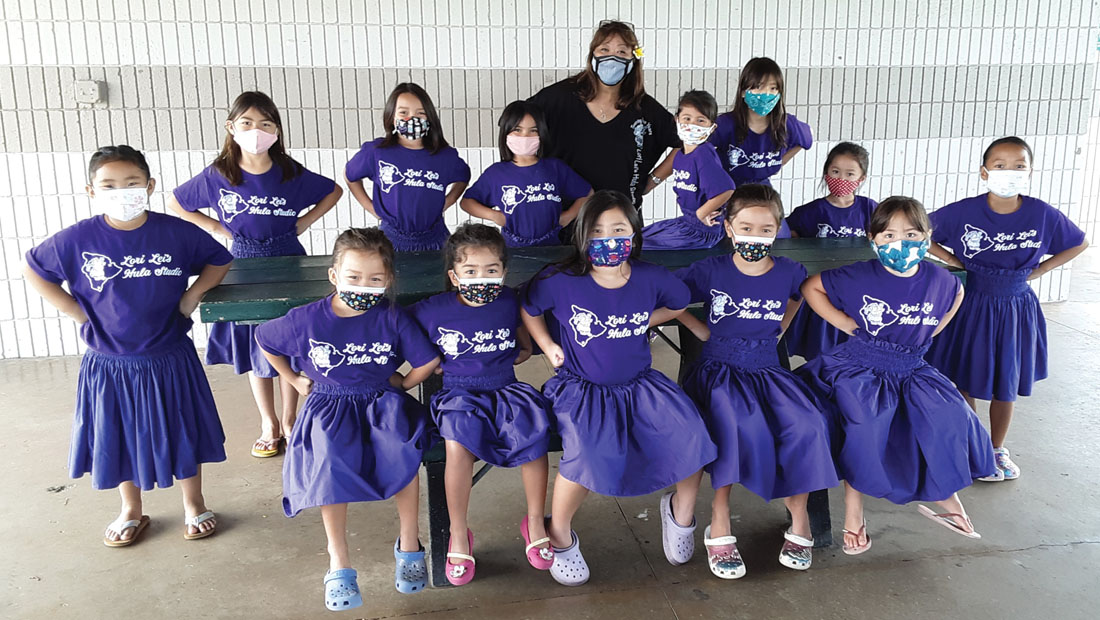
For more information: 808.938.2394
